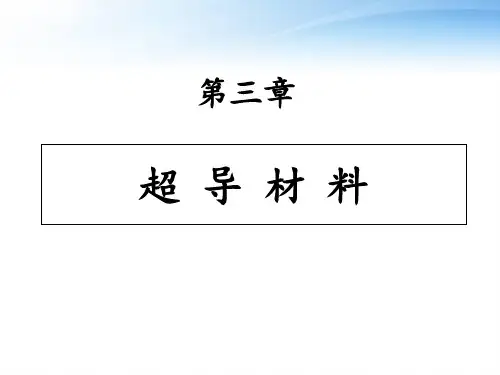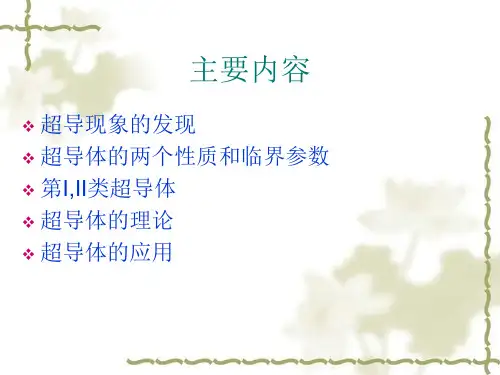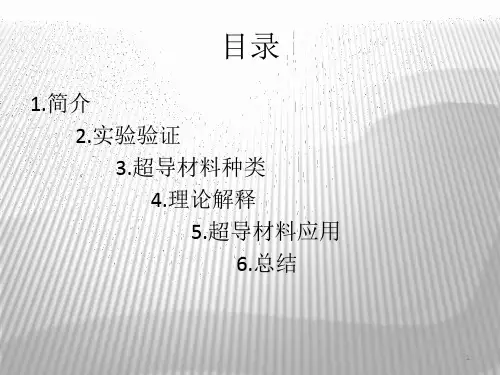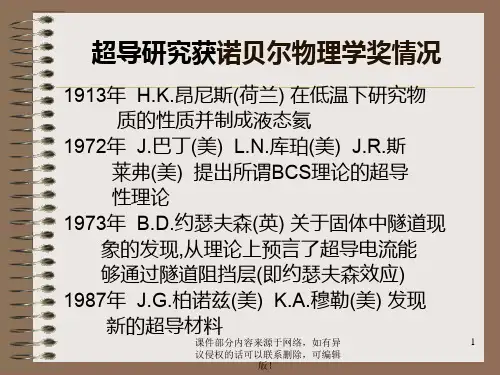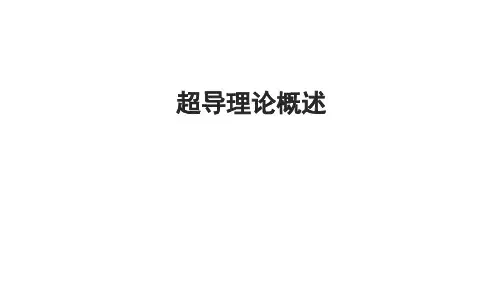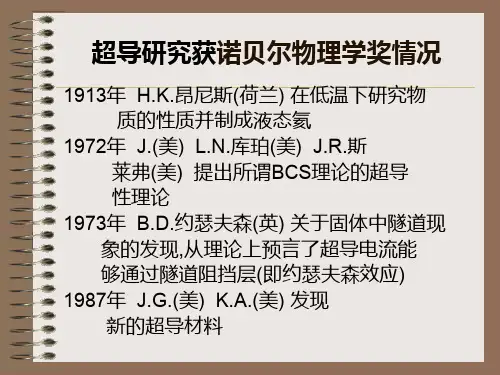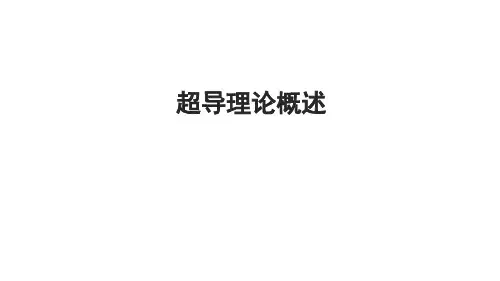- 1、下载文档前请自行甄别文档内容的完整性,平台不提供额外的编辑、内容补充、找答案等附加服务。
- 2、"仅部分预览"的文档,不可在线预览部分如存在完整性等问题,可反馈申请退款(可完整预览的文档不适用该条件!)。
- 3、如文档侵犯您的权益,请联系客服反馈,我们会尽快为您处理(人工客服工作时间:9:00-18:30)。
超导理论
• 超导现象与历史回顾 • BCS理论、规范不变性 • 准粒子与有限温度理论 • Bogoliubov-de Gennes理论 • Ginzburg-Landau理论
References: 1) “Theory of Superconductivity”, J. R. Schrieffer 2) “Superconductivity of Metals and Alloys”, P. G. de Gennes 3) “Introduction to Superconductivity”, M. Tinkham 4) J. Bardeen, L. N. Cooper, and J. R. Schrieffer, Phys. Rev. 108, 1175 (1957)
Model of Cooper problem
A Fermi sea + two extra electrons. The extra electrons interact with each other but not with those in the Fermi sea, except via the exclusion principle. At zero temperature, we only need to consider the wavefunction of two extra electrons.
Ground state solution to Cooper problem
Two-particle orbital wavefunction of zero total momentum
Spin states Symmetric state:
0 (1r , r2 )
g e e ik1 r 2 ik r
0
gk
gS k,
1
Spin-singlet, even-parity state
0 (r1 2r)
g eik r1 r2(
k
) S0
g k 1 r 2 r S0
k kF
kkk
F
Putting this wavefunction into the Schrödinger equation of thecporosb[lem(
)]
(E 2 k )kg
Vg
k ,k ' k '
k ' kF
where k is unperturbed single-particle energy, and the matrix elements of the interaction potential reads
V
k ,k '
1
( ) i(k ' k) dr r
k
k
S tot
1,S
tot z
1
S tot
1,S
tot z
01 2
S tot
1,Sห้องสมุดไป่ตู้
tot z
1
Antisymmetric state:
S tot 0 1 2
Fermions: antisymmetric wavefunction
0 (r1, r2)
g
k
e e ik 1r ik r
2S
k
gk
g ,S
k
1953, Pippard nonlocal generalization of London equations • 1950, Ginzburg and Landau, phenomenological theory • 1957, Bardeen, Cooper, Schrieffer, BCS theory • 1957, Abrikosov, type II superconductors • 1962, B.D. Josephson, Josephson effect • 1986, Bednorz and Müller, high-temperature cuprate superconductors,
V re
Bound state
E 2EF
Approximation:
Vk ,k '
V , |k (k ') F E | c
0,
otherwise
Tc=35K; Ching-Wu Chu, YBCO, Tc=92K • 2008, Hosono, iron-pnictide superconductors
Cooper pair
Cooper instability
Fermi surface is unstable against the formation of at least one bound pair, regardless of how weak the interaction is, so long as it is attractive. Such an instability only happen in many-fermion system, as a consequence of Pauli exclusion principle. In the two body system in 3D, there exists a finite threshold value for the attractive potential to form binding states.
Magnetic susceptibility
History of superconductivity
• 1911, Kamerlingh Onnes, vanishing electrical resistance in Hg, Pb, Sn • 1933, Meissner and Oschenfeld, perfect diamagnetism • 1935, F. London and H. London, electrodynamics in superconductors;
Superconductivity Phenomena
Perfect conductivity Perfect diamagnetism
Persistent current
not only a perfect metal
critical magnetic field
Meissner effect
Resistance
